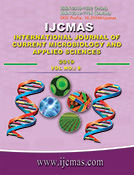


 National Academy of Agricultural Sciences (NAAS)
National Academy of Agricultural Sciences (NAAS)

|
PRINT ISSN : 2319-7692
Online ISSN : 2319-7706 Issues : 12 per year Publisher : Excellent Publishers Email : editorijcmas@gmail.com / submit@ijcmas.com Editor-in-chief: Dr.M.Prakash Index Copernicus ICV 2018: 95.39 NAAS RATING 2020: 5.38 |
A field investigation was carried out at Tamil Nadu Agricultural University, Coimbatore during kharif seasons of 2010 and 2011 to evaluate the weed control options for transgenic stacked (TC 1507 and NK 603) and non-transgenic maize hybrids. The experiments were conducted with the following objective to evaluate the weed control efficiency and crop productivity with K salt of glyphosate formulations under field conditions. Treatments consisted of two transgenic stacked hybrids named 30V92 and 30B11 applied with glyphosate as early post emergence at 900 and 1800 ga.e ha-1 during kharif, 2010 and conventional maize hybrids named 30V92 and 30B11 applied with glyphosate by controlled droplet application method at 900, 1350 and 1800 ga.e ha-1during kharif,2011compared with non-transgenic counterpart maize hybrids applied with pre emergence atrazine at 0.5 kg ha-1 followed by one hand weeding on 40 DAS with and without insect management. Among the treatments, Early POE application of glyphosate at 1800 ga.e ha-1 registered lower weed density and higher weed control efficiency in transgenic and non-transgenic maize hybrids at all the intervals. Higher grain yield was registered with post emergence application of glyphosate at 1800 ga.e ha-1 in transgenic and non transgenic maize hybrid of 30V92 during both the seasons of study.
 |
 |
 |
 |
 |